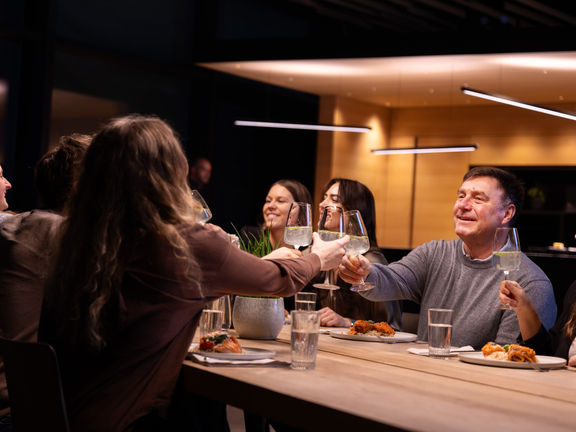

A romantic meal for two, a fun games night round the table with the family or a casual party with friends – the dining room is where life happens. An intelligent lighting concept over the dining table helps to create the right mood and a pleasant and appropriate atmosphere in all kinds of situations. What does the perfect dining room lighting look like? You can find ideas and inspiration here.

There’s a reason why we say that food is a feast for the eyes. Only when bathed in the right light can food be truly enjoyed. One of the reasons for this is that we unconsciously associate colours with certain flavours and aromas. For instance, bright red with the sweetness of tomatoes or the spiciness of chilli. So, the right lighting is a must, which means light in a colour temperature ranging from 2700 to 3000 K (kelvin). This optimally brings out the colours of food and has a homely effect.
The second important role of dining room lighting is to create a pleasant atmosphere. Ensure that the light over the dining table does not dazzle diners or produce a lot of shadows. Alongside these functional aspects, the emotive effect is an important factor. Above all, the brightness and interplay of light sources set the mood – from open and communicative to atmospheric or romantic. That’s why, when planning dining room lighting, it’s a good idea to bear different scenarios in mind.
For balanced lighting, a combination of two or more light sources is essential. Furthermore, natural light needs to be taken into account when designing the dining room.
Tip: to create indirect lighting in the dining room, you do not necessarily need an additional light. If you are still searching for ideas for your dining table lighting, take a look at BORA Horizon. Its innovative design combines the function of a pendant light and an indirect ceiling light.
If you have in mind the kind of dining table lighting you would like, you need to ensure that it suits the circumstances and creates the right effect. Here, it’s advisable to imagine a range of scenarios.

Think, for instance, about a meal with the family or a group of friends, where you have a laugh, eat and chat together. To create such an open, communicative mood, brighter light is recommended. To achieve this, you need bright basic lighting that actively supports the light over the dining table with additional lamps or light sources.
Another typical scenario is a romantic dinner for two. In this case, pendant lights play the main role, whilst the basic lighting stays in the background. A dimmer enables the brightness of the dining table lighting to be adjusted according to requirements. This function is extremely practical even for a romantic candlelit dinner. Without subtle additional lighting, candlelight is often too dim.
So, those are the basics of dining room lighting. To implement ideas in everyday life, it’s all about the details:

for optimal dining table lighting, a colour temperature of 2700 to 3000 K (kelvin) is recommended. This corresponds to the light colour warm white. The lower the colour temperature, the warmer the light appears.
To perfectly bring out the colours of food, the light needs to have a colour rendering index (Ra or CRI) of 80 or more.
The number of lumens that are exactly required at the dining table depends on the size and colour of the furniture and how the light source diffuses the light. In most cases, the luminous flux of the dining table light should be around 500 to 800 lumens. In terms of old light bulbs, this corresponds to a brightness of around 40 to 60 watts.
Dimmable light sources enable you to control the brightness of the dining areas according to your requirements. This is not only an advantage in the case of dining table lights but also in that of the general lighting.
Ideally, the dining table should be evenly lit. In the case of a long table, this can be achieved with a linear pendant light or two or three individual lights.
In general, the lamp should be 55 to 70 cm above the dining table. If you would like the flexibility to modify this distance, this can easily be achieved with a height-adjustable light. One such example is the BORA Horizon Move.